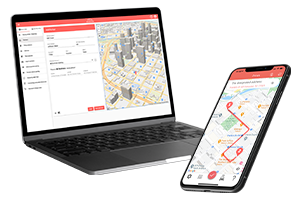Updated on March 1, 2024
What does car allowance mean? What is it supposed to cover? What are the other options when it comes to employee mileage reimbursement? Pros and cons for car allowance?
In this article, we intend to cover this wide topic in its entirety.
Let’s start with the foundations:
What is car allowance and how does it differ from other types of employee benefits?
An employee may get a car allowance as a type of payment to help defray the expense of driving their own automobile for work-related activities.
A car allowance is often not required and is frequently negotiated as part of an employment contract, in contrast to other employee perks like health insurance or retirement programs. Additionally, it is often not based on how well an individual does their work but rather on the particular obligations and duties assigned to their position.
A car allowance for employees is also typically granted as a predetermined monthly sum rather than being linked to the employee’s actual costs.
Who is eligible for a car allowance?
Depending on the organization itself and the particular employment roles, a wide range of different employees may be eligible for a car allowance. Employees who regularly use their own vehicles for work-related activities – such as going to meetings off-site or visiting customers – are usually the ones eligible for a car allowance.
How do employers determine eligibility for car allowance?
Employers frequently consider several factors when determining whether an employee qualifies for a car allowance, such as:
- the requirements of the position,
- the amount of driving necessary,
- the projected wear-and-tear on the employee’s own vehicle.
When determining if an employee qualifies for a vehicle allowance, employers may additionally take into account elements like the employee’s driving history and insurance coverage. Additionally, some companies may restrict automobile allowances to particular job titles or organizational levels.

How is a car allowance calculated? What factors affect the amount?
For employees who receive an auto allowance, some businesses may set a set flat-rate amount, while others may base the amount on the actual miles traveled for work. Depending on the employee’s driving style or the area they live in, the car allowance may occasionally need to be changed. For the cost-per-mile approach, it’s crucial to have an IRS-Proof mileage log.
Start My Automatic Mileage Log
The cost of gas, insurance, and upkeep for the employee’s own car, as well as the employer’s allocation for employee perks, are other elements that may influence the amount of a car allowance.
In the end, the precise criteria applied to determine a vehicle allowance may change depending on the employer’s regulations, the unique circumstances of the employee, and their job responsibilities.
Is car allowance considered taxable income in the US?
Yes, car allowance is generally considered taxable income in the United States. This means that the amount of the car allowance will be subject to federal income tax, as well as Social Security and Medicare taxes.
However, there are some situations in which an employer may be able to exclude a portion of the car allowance from taxable income, such as when the vehicle allowance is used to cover specific job-related expenses, like gas and maintenance.
Additionally, if an employer provides a vehicle to an employee for business use, the value of the vehicle may be subject to certain tax exclusions or deductions.
Employees who get a car allowance should speak with a tax expert to learn more about their unique tax liabilities and deductions.
What is a reasonable car allowance in the US?
In the US, the amount of a fair automobile allowance can vary based on several variables, including the employer’s regulations, the employee’s specific job requirements, and the area of the nation where the employee is situated.
A poll conducted by the Society for Human Resource Management (SHRM) found that in 2021, the median monthly automobile allowance for US employees was $550. However, depending on the particular circumstances, this sum might range from $100 each month to $1,000 or more. The average car allowance in the USA was $575 in 2021.
The thing is, a car allowance’s reasonableness will be determined by several variables, such as the cost of living in the employee’s location, the amount of driving necessary for the work, and the employee’s costs associated with vehicle ownership and maintenance.
Based on these elements and other circumstances, employers could occasionally modify automobile allowances.

Can I still receive mileage reimbursement for my business trips while getting a car allowance?
In the US, some firms might offer a car allowance in addition to mileage reimbursement, while others might only offer one or the other.
If an employee receives a car allowance, the money will likely be used to pay for all related costs, such as petrol, maintenance, and mileage, when driving a personal vehicle for work. The employee could not be qualified for further compensation for mileage in this situation.
However, in rare circumstances, an employer could offer a car allowance that is simply meant to cover specific costs related to driving a personal vehicle for work, such as petrol and upkeep. The company may additionally offer further compensation for the employee’s mileage costs in this situation.
Car Allowance and Employee Benefits

Navigating the realm of employee benefits can be complex, but when it comes to transportation, an auto allowance often stands out as a key perk for many professionals. In this guide, we’ll delve into the nuances of car allowances, highlight effective auto allowance policies, and address common questions with our FAQs. Whether you’re an employer looking to craft a car allowance policy template or an employee curious about your car allowance in California, this overview is designed to clarify and inform.
Understanding Auto Allowances
At its core, an auto allowance is a stipend provided by employers to cover the transportation expenses of their employees. This allowance can take various forms, including a cash for car allowance, a truck allowance, or a more structured FAVR (Fixed and Variable Rate) car allowance. The goal is to compensate employees for the business use of their personal vehicles, encompassing costs like fuel, maintenance, insurance, and depreciation.
Crafting an Auto Allowance Policy
A well-defined auto allowance policy is crucial for both clarity and fairness. This policy should outline eligibility, the amount of the allowance, and any necessary documentation for expenses. A car allowance policy template or a sample car allowance policy can serve as an excellent starting point for organizations looking to establish or revise their guidelines. Key components might include:
- Eligibility Criteria: Define which employees qualify for the allowance.
- Allowance Amount: Specify the monthly or annual allowance provided.
- Expense Reporting: Outline the process for submitting expense reports and the types of expenses covered.
State-Specific Considerations
Certain states, like California, have specific regulations governing car allowances. Employers in these jurisdictions must ensure that their policies comply with local laws, particularly regarding reimbursement rates and minimum wage adjustments.
Tax Implications
Understanding the returns and allowances schedule C is essential for both employers and employees. This tax form is used by sole proprietors to report income and expenses, including any auto allowances for employees. Proper documentation and adherence to IRS guidelines are vital to ensure compliance and avoid potential audits.
FAQs
Q: What is vehicle/car cash allowance?
A: A vehicle or car cash allowance is a fixed amount of money given to employees by their employer to compensate for the business use of their personal vehicle. This allowance is intended to cover the costs associated with operating and maintaining the vehicle. This allowance is taxable and is generally paid monthly.
Q: How much is a typical car allowance?
A: A typical car allowance can vary widely depending on the company, the industry, and the location. It generally ranges from a few hundred to over a thousand dollars per month. The amount is designed to cover the expenses associated with the business use of a personal vehicle, such as fuel, maintenance, insurance, and depreciation.
Q: How does a FAVR car allowance work?
A: A FAVR car allowance provides employees with a fixed amount for monthly vehicle expenses, plus a variable rate covering fuel, maintenance, and other operational costs, based on the miles driven for business purposes.
Q: Can a car allowance be used for any vehicle?
A: Generally, yes. An auto allowance is designed to cover business-related vehicle expenses, regardless of whether it’s a car, truck, or another type of automobile.
Q: Are car allowances taxable?
A: Car allowances can be taxable as income to the employee unless the employer uses an accountable plan that requires expense substantiation. Without proper documentation, allowances are subject to income and payroll taxes.
Q: How do employers determine the amount of a car allowance?
A: The amount can vary based on factors like the average cost of vehicle operation in the area, the expected mileage, and the type of vehicle required for the job. Employers may use industry benchmarks or a car/auto allowance policy sample to guide their decision-making.
In summary, an effective auto allowance for employees policy can significantly enhance a compensation package, providing both support and flexibility for work-related transportation needs. By carefully crafting a policy that considers legal, tax, and operational factors, organizations can ensure a mutually beneficial arrangement for all parties involved.
The standard mileage rate as employee mileage reimbursement
Employers can use the IRS standard mileage rate to pay workers for driving costs associated with work-related travel. The standard mileage rate for 2023 is 65.5 cents per mile.
The following details about the typical mileage rate as an employee mileage reimbursement are crucial to be aware of:
- Employers are not compelled to compensate employees for miles using the regular car mileage rates; instead, they are free to do so. They can instead opt to employ the actual expense method, which entails tracking, logging, and reimbursing real costs related to using a personal car for business.
- The standard mileage rate includes the following costs: petrol, maintenance, and depreciation incurred while operating a personal car for business activities. It does not pay for costs like registration fees, insurance, or tolls.
The standard mileage rate is normally revised by the IRS each year in accordance with changes in gas costs and other variables. If the market is as volatile as it was in 2022, there might be mid-year mileage rate changes as well.
Employees must maintain an accurate mileage log of the miles traveled for work reasons to be eligible for reimbursement at the standard mileage rate. This usually entails keeping account of the time, place, and purpose of each journey.
Start IRS-Proof Mileage Log For Free
IMPORTANT: Payment received in reimbursement for business-related travel up to the regular mileage rate is not regarded as taxable income. The extra amount, however, will be taxed if an employer reimburses it at a rate greater than the typical mileage rate.
Let’s see an example:
Dave drove 10,000 business miles in 2021.
In that year, the standard mileage rate was 56 cents, but his employer gave him 58 cents per mile that year so he could cover all business-related vehicle expenses, which was 5,800 for the whole year.
As you already know, mileage reimbursement is tax-free only up to the standard mileage rate in effect at that time, so it means that Dave needs to pay federal income tax for 200 dollars. ($5,800 minus $5,600 = $200).
FAVR: All you need to know about it
FAVR (which stands for Fixed And Variable Rates) essentially combines car allowance with a cost-per-mile type of calculation.
Under FAVR, the employer determines the amount of mileage reimbursement based on both fixed and variable expenses connected to using a personal vehicle for work-related activities.
Variable costs include things like petrol, maintenance, and repairs, while fixed costs often include things like insurance, depreciation, and registration fees.
Key things to know about FAVR:
- FAVR is calculated using actual costs: In contrast to the standard mileage rate, which pays employees according to a fixed rate per mile, FAVR pays employees according to their actual out-of-pocket costs for driving a personal car for work-related activities.
- FAVR may be more accurate: FAVR is usually a more accurate representation of the actual expenses spent by an employee since it accounts for both fixed and variable costs related to vehicle use.
- FAVR requires to you keep your records: To use FAVR, employees must maintain thorough records of their car expenditures, including gas receipts and maintenance logs.
- FAVR varies by location: Depending on the area of the country where an employee is based, the expenditures related to vehicle use may differ dramatically. As a result, depending on the employee’s location, FAVR rates may change.
In general, FAVR can be a more precise and fair method of paying employees back for their car expenditures, but it can also be more difficult and time-consuming to manage. Before employing FAVR as a reimbursement mechanism, employers should carefully weigh the advantages and disadvantages of doing so.

Speaking of weighing, let’s return to our original topic:
Pros and cons of car allowance for employees
Pros:
1. Flexibility: Car allowances provide workers more freedom to select their car and manage their mobility needs.
2. Cost savings: Since businesses don’t have to buy, maintain, and insure a fleet of automobiles, car allowances may be less expensive for them than giving a corporate car.
3. Tax benefits: If it’s done the proper way, employers may be able to deduct car expenses, and employees may not have to pay payroll taxes on them.
4. Employee recruitment & retention: Giving employees a fair amount of vehicle allowance or a more complex program like FAVR may be a well-liked perk, which can help tremendously in employee recruitment and retention efforts.
Cons:
1. Administrative burden: Giving employees a vehicle allowance can increase the amount of administrative labor businesses have to do to guarantee that tax & accounting regulations are followed.
2. Employee liability: When given a car allowance, an employee is in charge of all expenses and hazards related to purchasing and maintaining a personal vehicle.
3. Unfair reimbursement: Car allowances might result in unfair reimbursement since workers who drive more for work or who have more costly automobiles may be compensated more than others who drive less or have less expensive vehicles. Again, by switching to FAVR, this issue can be solved.
4. Potential for inequity: In some circumstances, giving employees a vehicle allowance may be viewed as unfair or inequitable, especially if some employees are not qualified for the benefit or if the allowance amounts vary widely. This is something the company has to communicate & treat cautiously and consistently.
In conclusion, giving employees a vehicle allowance may be a smart approach to provide them freedom and cost savings, but it’s crucial to carefully assess the benefits and drawbacks before designing a program that is fair and equal for all employees.
Flexible reimbursement & FAVR: How to track mileage for work
Paying car allowance in itself does not necessarily require mileage tracking – even though it would help the fair payments.
However, if you do choose to provide a more flexible (and oftentimes more fair) mileage reimbursement solution to your employee like cost-per-mile reimbursement, or combine both in FAVR, you’re both much better off equipping them with a bulletproof mileage tracker app & a supporting dashboard.
MileageWise’s automatic mileage tracker app (downloadable for both iOS & Android phones) provides 3+1 automatic trip tracking modes and automatic trip classification as well, in a battery & data-friendly mode – it doesn’t track you along your entire journeys, it only records the points of arrival and then connects the dots.
You can later edit these trips and finalize them in just 7 minutes each month.
If you’re missing some miles or trips, MileageWise’s AI Wizard function gives you recommendations for your trips. This way, fixing your mileage log by filling the gaps in it is easier than ever!
MileageWise also has a built-in IRS auditor feature, which checks & corrects 70 logical contradictions in your mileage log before letting you print it. This is the feature that ensures that your mileage log is 100% IRS-Proof when you print it.



